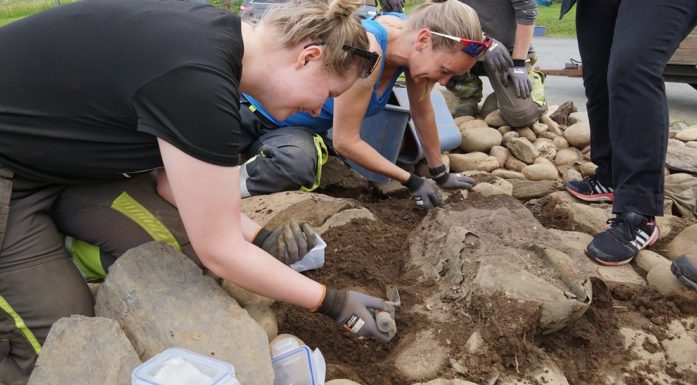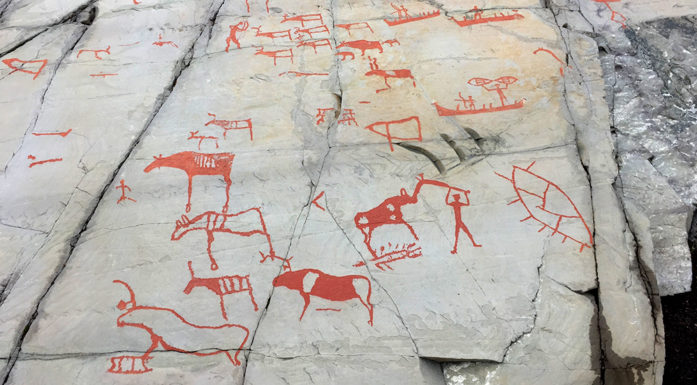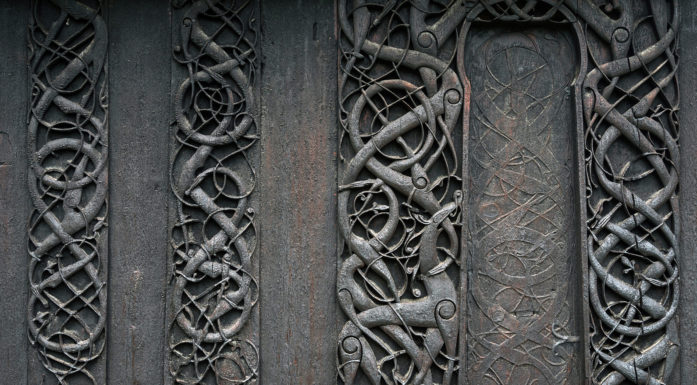How forgetting about Middle Age treasures saved them
One of Scandinavia’s finest collections of church art from the Middle Ages lay hidden and forgotten in Norwegian churches for centuries. Indeed, this long forgetting is precisely what preserved the unique church art.
In the Middle Ages, Norway’s churches were filled with holy figures, statues of the Virgin Mary and crucifixes. The wooden sculptures were painted and decorated with bright colours.
When people went to Mass, they would turn to the sculptures to ask for help, forgiveness and comfort. They had a close relationship with the sculptures, gave them gifts and adorned them in beautiful clothes.
Sigrid Undset describes this in her trilogy Kristin Lavransdatter, which takes place in 14th century Norway. Kristin goes to the Christ Church where she sees statues of holy men and women along the galleries. Undset describes the statues as being so beautiful that Kristin didn’t dare look up at them.
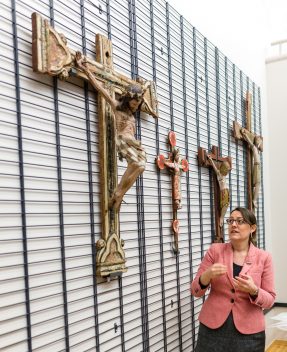
Art historian Margrethe C. Stang is pleased that the church art collection is seeing the light of day once again. Photo: Julie Gloppe Solem / NTNU
Fabulous colours
The NTNU University Museum in Trondheim is home to a large collection of church art from the Middle Ages. The original colours of the Middle Ages are largely preserved on the sculptures, which makes them particularly unique.
“It’s exciting that so much of this pre-Reformation art is surfacing here in the north. Of course, in Catholic countries, many figures of saints, crucifixes and medieval Madonna figures have been preserved, but these have been in continuous use and have been repaired and restored several times. By contrast, many of the medieval sculptures we have in Norway are intact and original,” says Margrethe C. Stang, Associate Professor at NTNU’s Department of Art and Media Studies, and a specialist in medieval Norwegian church art.
Hidden and forgotten
After the Reformation in 1537, when Norway made the shift from Catholicism to Protestantism, church ornamentation gradually changed. Lutheran belief did not accord the saints any importance, and the sculptures were disdained in the first Reformation period. Yet only a few instances of destroyed Catholic art are known.
“The medieval Catholic sculptures were gradually forgotten in Norway, and this fact enabled the painting on many of the sculptures to remain intact. The original painting alone makes them very valuable to those of us who are interested in the original expressions. We’re incredibly lucky to have so many fine examples here in Trondheim,” says Stang.
Church art in Norway is housed in four major collections, located in Trondheim, Bergen, Tromsø and Oslo. The objects in the NTNU University Museum were collected from churches in the Nidaros diocese, which originally comprised all of northern Norway, consisting of the area north of Trondheim and the Dovre region.
“Medieval church art may sound peculiar, but in fact, most of the art created at that time was linked to the church,” Stang says.
Only one Trondheim sculpture preserved
The Nidaros diocese was an important centre of ecclesiastical life in the Middle Ages, and Nidaros Cathedral led the trends of the day in church ornamentation. The village churches on the outskirts, on the other hand, often held onto the old sculptures.
“The churches furthest from Trondheim have the best kept church treasures. In these places the old art was preserved, both because smaller parishes couldn’t afford to swap it out and because people were attached to what they knew and maintained the old traditions,” says Stang.
Only one sculpture from Trondheim’s medieval churches – a Mary figure with child from the Hospitalskirken (Hospital Church) – has been preserved.
Waking up after a 400-year-long night
While Norway was under Danish rule – a period of 400 years – Norway’s art took a back seat. Norwegian art and culture were held in relatively low regard, both within the country and abroad. However, after 1814, Norway began to rebuild its self-esteem and sought expression in Norwegian culture to assert its own distinct cultural identity.
A romantic nationalism movement erupted throughout the country, founded on Norway’s rural traditions and the ornamental styles of the Viking Age. Suddenly the Middle Ages gained status as high culture.
A number of interested people began to collect and preserve artefacts from the Norwegian countryside, including those found in the churches in rural districts. Many of the objects had been stowed away and practically forgotten. And this is exactly what helped to preserve them.
“The collectors were worried that the congregations didn’t recognize the value of these objects, and that the priests regarded them as Catholic and therefore inappropriate,” says Stang.
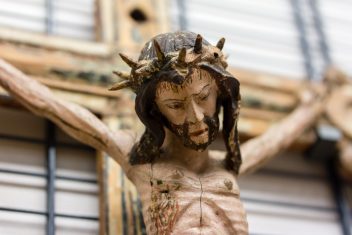
This crucifix from Hov church is one of the treasures of the church art collection. Photo: Julie Gloppe Solem / NTNU
Surprised by the quality
The first round of collecting took place early in the 19th century. The NTNU University Museum received the artefacts and took them into their care.
“When experts eventually began to study the church art that was collected, they were surprised at the high quality of the artistry and craftsmanship,” says Stang.
“They were especially surprised that a lot of the objects had been produced in Trondheim, because at that time people didn’t believe such fine art could be created in Norway. In the early 19th century, just the idea that people had created exquisite works of art in Norway in the Middle Ages was incredibly strange. It was generally believed that things like that were all imported.
Battle of Stiklestad 1000th anniversary
For several decades, the collection has been packed away due to lack of space at the museum. Now the collection is returning to light and is available to students and PhD fellows who are studying this particular time period.
The museum is also opening the sculptures to the public on certain days. However, the several-hundred-year-old objects are vulnerable and must be stored in rooms with the proper temperature, humidity and light.
The Battle at Stiklestad marks the introduction of Christianity to Norway, and for the 900th anniversary in 1930 a large-scale exhibit in Trondheim put the church treasures on display to mark the occasion.
“It would be exciting if we could celebrate the 1000th anniversary of the Battle of Stiklestad, in 2030, with a reprise of the grand 1930 exhibition,” said Stang, who is very pleased that the collection has again become accessible.
